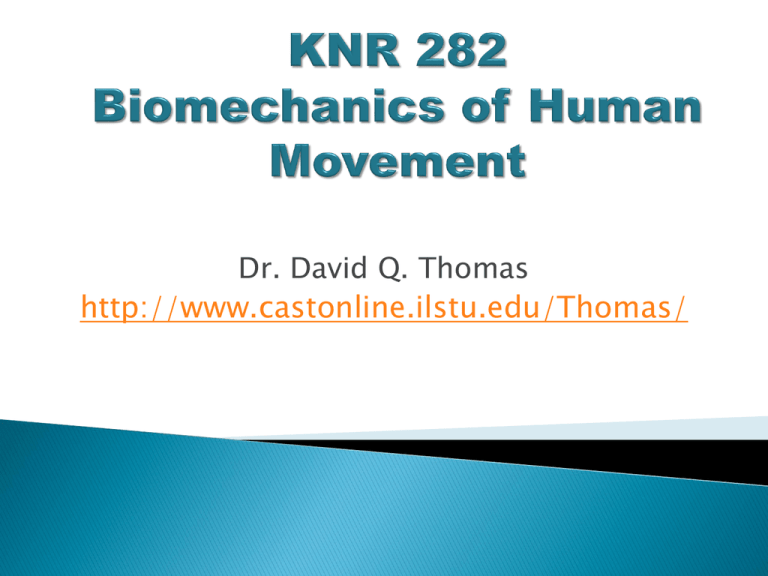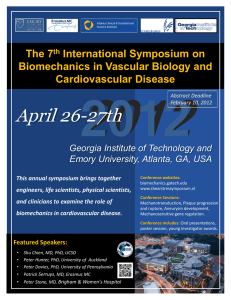Biomechanics Notes Chapter 1 What is biomechanics?
advertisement

Dr. David Q. Thomas http://www.castonline.ilstu.edu/Thomas/ Credit goes to Dr. McCaw for his contributions to these slides. Traditional teaching and coaching methods tell you what techniques to teach or coach Biomechanics tells you why those techniques are best to teach or coach It can also tell you why some teaching and coaching techniques don’t work and need to be discontinued AT, OT, and PT students will benefit from learning biomechanics because it will help in: ◦ determining the cause of injury, ◦ aid in preventing future injury, ◦ and guide in determining best methods for rehabilitation. Exercise science students will learn the best techniques for improving fitness and enhancing exercise performance PETE students will learn how to make instructional decisions based on the science of human movement I will provide you with ◦ Concept ◦ Examples You need to come up with ◦ Application How does this concept apply to: Physical Education Teacher Education? Exercise Science? Athletic Training? Kines: Latin ==> “motion” logos: “study of” Kinesiology = Study of Motion Includes: Anatomy & Physiology Psychology Motor Development Pedagogy Biomechanics Exercise Physiology Athletic Training Bio = life Mechanics - study of machines Biomechanics - study of living machines science concerned with effects of forces acting on a system (body) Rigid Body Mechanics Statics -at rest -constant velocity Dynamics -changing motion (acceleration) Kinematics -description of motion Kinetics -study of the forces that cause or tend to cause the changes in motion We study biomechanics to understand how people move This information may be used to enhance performance by improving technique It may also be used to lower the risk for injury Enhance skill performance ◦ Technique improvement Improve current technique (shooting a foul shot) Develop new technique (Fosbury Flop, swim hand recovery, skating in X-country skiing, ski jumping) ◦ Equipment improvement Shoes and apparel Implements Protection devices ◦ Training improvement Injury Prevention and Rehabilitation ◦ Techniques to reduce injury ◦ Equipment designs to reduce injury To understand how living bodies can move. To understand how people can move. To understand how people can move. ◦ To enhance skill performance elite athletes USOC, WNBA, MLB, etc Biomechanics in the Olympics http://www.youtube.com/watch?v=csrbGCUxzg&feature=related An example using anthropometrics Study of the body’s size and form This would include measurements of: Height Weight Circumferences Skinfolds Girths/diameters Etc Ave Average Hand/Ht Hand Ball hand/ball Ht Ht (inches) Ratio Length Size (inches) ratio Male 6'7'' 79 0.108 8.53 29.625 0.288 Female 6' 72 0.108 7.78 28.625 0.272 Average NBAers hand is 28.8% of ball length Average WNBAers hand is 27.2% of ball length How big should the WNBA ball be to equate males & females? 7.78/0.288 = 27.014 inches To allow for comparisons Strength Males Versus Females Destroy myths Can a cow really jump over the moon? http://zebu.uoregon.edu/~dmason/probs/mech/work/cow moon/cowmoon.html To understand how people can move. ◦ To enhance skill performance physical challenges ACL deficit CP gait Wheelchair Age-related disease To understand how people can move. ◦ To enhance skill performance physical challenges ACL deficit CP gait Wheelchair Age-related disease To understand how people can move. ◦ To enhance skill performance Physical development To understand how people can move. ◦ To enhance skill performance Improve equipment Biomechanics and Safety To understand how people can move. ◦ To enhance skill performance Not limited to humans To understand how people can move. ◦ To enhance skill performance ◦ To lower the risk for injury Exercise equipment & technique shoes & surfaces braces & orthotics Equine biomechanics http://www.equinemechanics.com/ To understand how people can move. ◦ To enhance skill performance ◦ To lower the risk for injury Automobiles collisions http://collisionresearchltd.com/index.php To understand how people can move. ◦ To enhance skill performance ◦ To lower the risk for injury Automobiles collisions To understand how people can move. Vsevolod Meyerhold’s Biomechanical Theatre 1920’s To understand how people can move. Borelli Borelli’s major scientific achievements are focused around his investigation into biomechanics. This work originated with his studies of animals. His publications, De Motu Animalium I and De Motu Animalium II, relate animals to machines and utilize mathematics to prove his theories. The anatomists of the 17th century were the first to suggest the contractile movement of muscles. Borelli, however, first suggested that ‘muscles do not exercise vital movement otherwise than by contracting.’ He was also the first to deny corpuscular influence on the movements of muscles. This was proven through his scientific experiments demonstrating that living muscle did not release corpuscles into water when cut. Borelli also recognized that forward motion entailed movement of a body’s center of gravity forward, which was then followed by the swinging of its limbs in order to maintain balance. His studies also extended beyond muscle and locomotion. In particular he likened the action of the heart to that of a piston. For this to work properly he derived the idea that the arteries have be elastic. For these discoveries, Borelli is labeled as the father of modern biomechanics. http://en.wikipedia.org/wiki/Giovanni_Alfonso_Borelli To understand how people can move. ◦ To enhance skill performance ◦ To lower the risk for injury To understand how people can move. ◦ To enhance skill performance ◦ To lower the risk for injury To understand how people can move. ◦ To enhance skill performance ◦ To lower the risk for injury Some of us are not doing a good job ◦ Coach: focus on strategy ◦ Teaching skills: “farm system” vs fitness: CV & strength Cater to the converted. Serve the skilled. We treat symptoms of an injury, with less emphasis on etiology (cause) of an injury ◦ placebo effect vs true treatment effects ◦ high rate of reoccurrence Safety & Performance Trade-Off Quantitative analysis - mainly a clinical research perspective. Qualitative analysis - most teachers/coaches need this ability. Science concerned with the effects of forces acting on objects (body) ◦ body: focus of the analysis human body individual body segment specific tissue / anatomical site balls, pucks implement: bat, stick, club Science concerned with the effects of forces acting on objects (body) ◦ ◦ ◦ ◦ ◦ Rigid-body mechanics Deformable body mechanics Fluid mechanics Relativistic mechanics Quantum mechanics Acceptable for analyzing gross movements Assumptions ◦ body does not deform by bending, stretching or compressing ◦ segments are rigid links joined by frictionless hinges at joints Rigid Body Mechanics Statics -at rest -constant velocity Dynamics -changing motion (acceleration) Kinematics -description of motion Kinetics -study of the forces that cause or tend to cause the changes in motion Length - of what size? Time - of what duration? Mass - how much matter? Inertia - what resistance to movement? Describe someone out for a run Describe someone out for a run ◦ Kinematics How How How How far did she run? long to run that far? fast was she? big is she? ◦ Kinetics What friction under her feet? What forces on her joints? What tension in her muscles? Measure to describe ◦ location at a particular point in her run ◦ how far she ran Feet, inches, miles Systeme Internationale d’Unites (SI) ◦ meter ◦ 1 m = 3.28 feet = 39 inches http://physics.nist.gov/cuu/Units/ Measure to describe how long it takes her seconds, minutes, hours, days, months, years Systeme Internationale d’Unites (SI) ◦ second (s) Space to move in and time during which to move speed & velocity==> length per unit of time ◦ miles per hour ◦ m / s or m . sec-1 acceleration ◦ m/s/s or m . sec-1 . sec-1 Inertia ◦ resistance to a change in state of motion Who is harder to start or stop moving ◦ Olympic weight lifter ◦ Olympic gymnast Inertia ◦ resistance to a change in state of motion Who is harder to start or stop moving ◦ Olympic weight lifter: has more inertia ◦ Olympic gymnast Inertia ◦ resistance to a change in state of motion Mass ◦ the quantity of matter a body possesses ◦ quantifies inertia (the measure of inertia) Greater mass, greater inertia resistance to change state of motion ◦ units are kilogram (kg) or slug (English) ◦ Not the same as weight Provide an example of changing motion in ◦ sport ◦ exercise ◦ workplace Provide an example of changing motion in ◦ Sport: size expectations of different positions (i.e. interior defensive linemen) ◦ Exercise: alter mass to be moved to increase load on NMS system (i.e. push-up) ◦ Workplace: alter mass of components to reduce load (i.e. cement bags, engine blocks) Length Time Mass All that is needed to describe and explain the motion of objects Force: defined from the above ◦ a push or pull acting on a body Biomechanics Lab at ISU Research Not to know is bad. Not to wish to know is worse.






